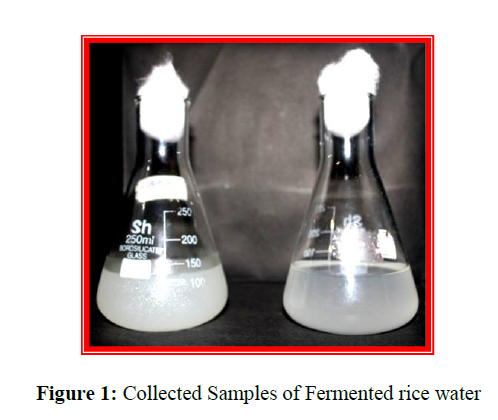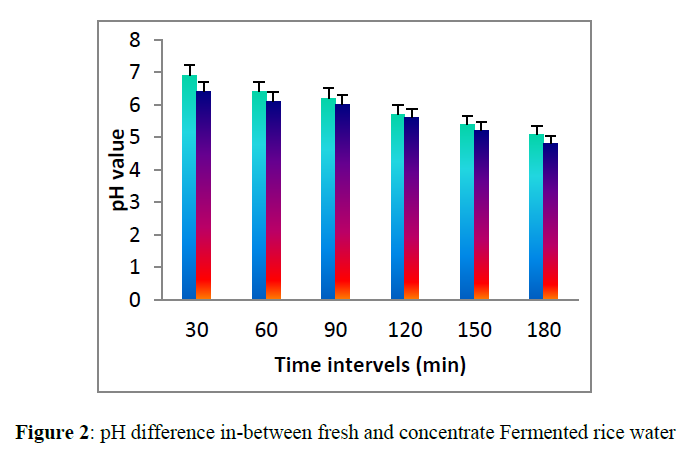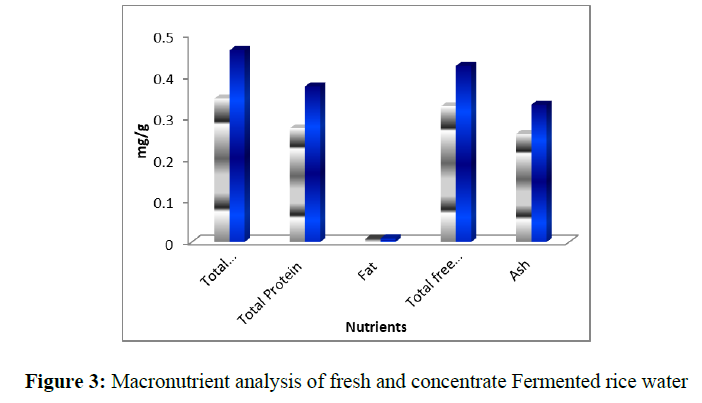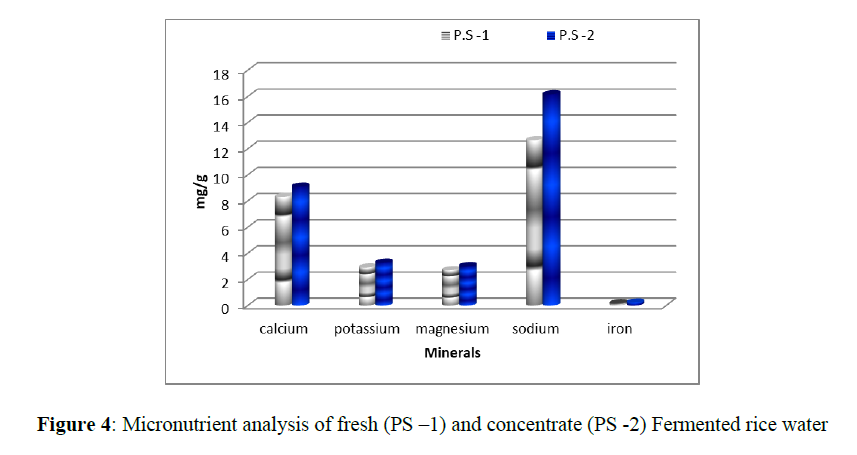Research Article - Der Pharma Chemica ( 2021) Volume 13, Issue 7
Nutritional Analysis and Antimicrobial Activity of Fermented Rice Water
H. Fendic Shano1, T. Kumaran2*, T. Sherin Mary1,2, M. Jenifer Tamizharasi1,2, R. Rajila2, S. Sujithra2 and Beula shiny22Research Department of Zoology, Muslim Arts College, Affiliated to Manonmaniam Sundaranar University, Thiruvithancode, Kanyakumari- 629174, India
T. Kumaran, Department of Nutrition and Dietetics, Muslim Arts College, Thiruvithancode, Kanyakumari, 629174, Tamilnadu, India, Email: kumaranmac@gmail.com
Received: 25-Jun-2021 Accepted Date: Jul 19, 2021 ; Published: 26-Jul-2021
Abstract
Malnutrition and poor health are the major burdens in the developing as well as under developed countries. The fermented rice-based food formulation may be the God's gift as this improves the overall nutritive capacity and has an added advantage of physiological functions. Some of them have been scientifically investigated and it has been revealed that micro flora in natural or starter culture plays imperative roles to bio-embolden the rice with varieties of health promoting macro- and micro-nutrients, phytochemicals, and other functional components during fermentation. In the present study results, fermented rice water is sour, translucent in colour and also has very high nutritional value. It is a very good source of vitamins, minerals and amino acids. Products were formulated and sensory evaluation was done by selected panel members. Concentrated fermented rice water is a nutritious drink. It contains a number of minerals and salts. It has been medically proved that fermented rice water is better than mineral water. Fermented rice water syrup is used as a health drink in connection with ayurveda and other systems of medicine
Keywords
Fermented rice water, concentrate, medicine, translucent, micro nutrients
Introduction
Fermentation is one of the major methods of adding nutritional values to food. The fermented rice also possesses “probiotics” activity. The lactic acid bacteria present in fermented rice breakdown the anti-nutritional factors in the rice resulting in an improved bioavailability of micro-nutrients and minerals such as iron, potassium and calcium. These activities are enhanced by the phenolic compounds which are p-hydroxybenzoic acid derivative and syringic acids and hydroxycinnamics derivatives present in fermented rice [1].
Cereal grains are considered to be one of the most important sources of dietary proteins, carbohydrates, vitamins, minerals and fibre for people all over the world. However the nutritional quality of cereals and the sensorial properties of their products are sometimes inferior or poor in comparision with milk and milk products. The reasons behind this are the lower protein content, the deficiency of certain essential amino acids (Lysine), the low starch availability, and the presence of determined antinutrients phytic acid, tannins and poly phenols and the coarse nature of the grains.
Global interest in cereal-based fermented products is increasing due to low fat cholesterol high minerals dietary fibers and phytochemicals content. Beyond the basic nutrients, cereal based fermented food confers several health promoting attributes as it contains edible beneficial microbes, also called probiotics; fermentable sugars (of microbial and food origin, i.e. prebiotics), and digestive aids such as a group of microbe-derived hydrolytic enzymes, etc.. Besides, multi-strain or multispecies probiotic may provide greater beneficial effects than monostrain cultures. The synergistic action of these exogenous microbiota create a sociable environment for commensals (native colonizing organisms), prevent the growth of otherwise enteropathogens, beneficial for digestion and absorption, produced different metabolites including short chain fatty acid (SCFA), especially butyrate, which have a positive effect on epithelial lining of the GI tract, enhance mucosal cell differentiation and this may also promote the immune barrier function of the epithelium, and on peristalsis, which improves transit [2,3].
Rice-containing foods are fermented by a mixed culture of microorganisms by spontaneous fermentation and, in the case of beverages, by adding a starter culture. These are prepared in the households or in cottage industries using relatively simple techniques and equipment [4]. In the recent past, there were no verified data on the nutritional, technical, and quality control implications of indigenous rice-based fermented food products in India, the second most populated rice production country in the world. However, in the last 20 years, a number of books and articles dealing with indigenous rice-based fermented beverages and foods have been published. In this context, this review focuses on the unexplored mystery of microbial interplay in rice based indigenous fermented foods and beverages, and emphasizes the importance of the bioactive functional biomolecules.
Material and Methods
Preparation and Collection of fermented rice water sample
The raw white rice (150 gm) was cooked with water for 30 mins, excess water was drained and allowed to cool at room temperature. The cooked white rice (100 gm) was soaked in 500 ml of sterile distilled water [rice: water (1:5) and stored in a container. Overnight fermentation was carried out at room temperature. The fermented white rice water sample was collected 0 hour and 24 hours. 50 ml of 0 hour and 24 hours fermented rice water was pipetted out separately into clean glass beakers to characterize the quantitative and qualitative content of phenols. 2 ml from each of the fermented rice water was transferred into clean eppendroff for further organism isolation process for every 24 hours.
Physical factors
Physical factors such as Colour, Odour, Taste, pH, Turbidity were determined for both fermented rice water fresh and fermented rice water concentrate using standard procedures and were noted.
Nutritional factors
Macro and micronutrients were analysed both for fermented rice water fresh and Fermented rice water concentrate using standard procedures.
Macronutrients
Macronutrients such as carbohydrate, protein, fat, total free aminoacids and ash content were analysed. Carbohydrate was analysed by Anthrone method and protein as analysed by Lo rey’s method [5].
Micronutrients
Minerals
Fermented rice water contain a wealth of mineral elements. The micronutrients namely calcium, magnesium, potassium, sodium and iron were analysed by standard AOAC methods [6].
Formulation of the product
Fermented rice water was selected for the preparation of the product. Fermented rice water fresh and concentrate incorporated drink are prepared using standard procedure and the best product was selected.
Acceptability and Sensory evaluation of Fermented rice water concentrate incorporated drink
The use of standardized recipes ensures that menu items will be consistent in quality each time they are prepared and served. It will also ensure that nutritional values per serving are valid and consistent. The recipes were standardized in terms of the ingredients used, the quantity of each ingredient and the time taken for cooking. Sensory properties, among many other factors influence considerably the quality of food products. Sensory assessment was evaluated on the quality descriptions ie) appearance, taste, color, flavor, texture and over all acceptability using a score card. Score card is a tool which helps in evaluation through direction and degree of judgment using suitable defined scores. Evaluation was carried out for the sample and standard products. They were evaluated by a panel of 20 semi trained panel members from the Department of Nutrition and Dietetics, Muslim Arts College, Thiruvithancode, Kanyakumari District. The panel members did the organoleptic evaluation of these recipes based on five point hedonic scale developed by [7]. The mean score of the organoleptic evaluation was calculated and on the basis of the total obtained scores.
Results
Physical and chemical factors
Physical factors: Colour, Odour, Taste, pH and Turbidity
Colour of the sample Fermented rice water and concentrate was measured by using 1.245g of potassium chloroplatinate and 1 g of cobaltous chloride dissolved in distilled water and makes it to 1000 ml. The colour of fresh is in white and concentrate is in milky white. In case of odour, fresh evolves sweet smell but concentrate gives sour smell with foam which indicates formation of carbon dioxide. Taste of the fresh is better than the concentrate taste. Fermented rice water concentrate was sour/ tangy due to the acidic level.
Fermented rice water fresh is in sweet taste when it undergoes fermentation taste converts into sour. The pH falls sharply within 3 hours in both and concentrate. The fall is from near neutral of pH 6.7 to pH 5.1. In case of concentrate, the pH rate decreases very sharply within 3 hours the pH converts from 4.2 to 3.1. After 12 hours, the pH stabilizes around 2.5 in concentrate. The turbidity of fresh fermented rice water was slightly transparent solution, but in the case of concentrate it is different. Turbidity indicating the growth rate of microorganisms (or) fermentation rate was enhanced due to higher fermentation processing. (Figure 1,2)
Nutritional evaluation
Macronutrient composition
The results of macronutrient composition analysis are shown in Table. The total carbohydrate 0.461mg/g and total protein (0.374 mg/g) content were higher in Fermented rice water concentrate. The total carbohydrate 0.345 mg/g and total protein (0.273 mg/g) content were respectively. The fat content was lower in (0.008 mg/g) and (0.009 mg/g). Total free amino acids (0.423 mg/g) and ash (0.33 mg/g) contents were respectively higher in fermented rice water concentrate. Total free amino acid content was lower in fermented rice water fresh (0.326 mg/g) and ash (0.26 mg/g) when compared to others.(Figure 3)
Micronutrient composition of Fermented rice water
The results of micronutrient composition analysis are shown in Table. The calcium content was lower in (8.3 mg/g) and higher in (9.1 mg/g). Potassium level (3.28 mg/g) magnesium 3.01mg/g, sodium 16.17 mg/g and iron (0.23 mg/g) contents were respectively higher in Fermented rice water concentrate. The magnesium 2.71mg/g, sodium 12.65 mg/g and potassium (2.91 mg/g) and iron (0.18 mg/g) content were respectively lower in fresh Fermented rice water. (Figure 4)
Sensory evaluation
The sensory analysis of the formulated product is given below. The sensory parameters such as appearance, taste, texture, flavor, color and overall acceptability of Fermented rice water concentrate incorporated drink shows the best compared to Fermented rice water fresh incorporated drink.
Mean acceptability scores of Fermented rice water concentrate incorporated drink
The selected Fermented rice water concentrate were incorporated at different levels of incorporation ranging from 5, 10 and 15 per cent. The recipe prepared were evaluated for acceptability by five point hedonic rating scales. Table 1 shows the mean acceptability scores of Fermented rice water concentrate incorporated recipe. Results revealed that the mean total score of 5-15 per cent incorporated Fermented rice water concentrate drink were found to be possess 4.42, 4.05 and 3.72 percent as the mean scores, when compared to the standard with the mean score of 4.54 respectively.
| Level of incorporation (%) | |||||
|---|---|---|---|---|---|
| Sl. No | Attributes | Standard | 5% | 10% | 15% |
| 1 | Appearance | 4.8 | 4.3 | 4 | 3.55 |
| 2 | Colour | 4.2 | 4.5 | 4.2 | 4.1 |
| 3 | Flavour | 4.5 | 4.3 | 3.76 | 3.5 |
| 4 | Texture | 4.8 | 4.4 | 4 | 3.6 |
| 5 | Taste | 4.4 | 4.6 | 4.3 | 4 |
| Mean acceptability score | 4.54 | 4.42 | 4.05 | 3.72 | |
Table 1: Mean acceptability scores of Fermented rice water concentrate incorporated drink
Overall mean acceptability score of Fermented rice water concentrate incorporated drink
The overall acceptability of score of Fermented rice water concentrate incorporated drink revealed that five per cent incorporation scored higher with respect to the sensory attributes of appearance, color, flavor, texture and taste when compared with 10 – 15 per cent incorporated formulation. Fermented rice water concentrate incorporated drink had secured the highest scores and found to be highly acceptable than milk drink.
Discussion
Protein and carbohydrates were moderately present in the fermented rice water, while fat and ash in least concentrations. Quantitative estimation of minor components in dried powdered fermented rice water revealed the presence of free amino acids, vitamin C, vitamin E, minerals like sodium and potassium. The macronutrient analysis of Fermented rice water showed the presence of carbohydrates in high concentration and proteins and amino acids in moderate concentration, whereas, fats and oils were absent. The contents of both monosaccharides enhance the final reducing sugars content of the Fermented rice water; because they could probably be the main reducing sugars of Fermented rice water. Essential trace elements such as Calcium, Magnesium, Iron, Sodium, Potassium and Selnium were determined by using inductively coupled plasma optical emission spectrometry (ICP-OES) method.
The minerals such as Calcium (9.23 mg/100 g) and Sodium (17.18 mg/100 g) are rich in the sample Source 2. The determination of the presence of selenium (0.2 to 0.3 mg/100 g) in this fermented rice can be explained as a preventive mechanism to cancer as natural source of mineral availability [8].
Traditional siddha medical literature indicates the medicinal properties of „Palam Sooru‟ such as reduce body heat cures peptic ulcer, abdominal pain and constipation. Fermented rice water known as Palamsootru kanchi or Nisineer also used as healthy water in natural medicine in folklore practice in ancient times. It provides energy and helps with stomach issues like bloating, constipation and diarrhea, thus prevent dehydration act as effective electrolyte solution. In addition regulate the body temperature and also protect skin from the sun due to cooling effect and cures acne and red blisters of the face. Due to optimal PH of fermented rice water, it keeps hair shiny, long hair, improving skin elasticity, reducing surface friction and preventing grey hair. In spite of its great importance in day to day human life, scientific approaches with respect to microbial and chemical studies are not much expedited. Therefore the present generation is reluctant to take these types of traditional foods nowadays [9].
The presence of phytic acid in rice and other food grains decreases the bioavailability of micronutrients such as phosphorous, magnesium, iron and zinc. It also inhibits the enzymes pepsin, amylase and trypsin. Due to the nutrient inhibiting property phytate is considered an anti-nutrient. The fermented rice which was consumed by most of the ancient people has several health benefits. In conclusion, the results of the present study indicate that the fermented rice water possesses significant health benefits. It exerts these beneficial effects mainly due to the presence of various nutritional factors.
References
- Martins S, Mussatro SI, Martinez-Avila G et al., Biotechnol Adv. 2011, 29: p. 365-73.
- Charalampopoulos D, Pandiella SS and Webb C. J Appl Microbiol. 2002, 92: p. 851-859.
- Nout MJR. Food Microbiol. 2009, 26: p. 685-692.
- Ghosh K, Maity C, Adak A et al., Ethnobot Res App. 2014, 12: p. 39-49.
- Lowry OH, Rosebrough NJ, Farr AL et al., J bio chemistry. 1915, 193: p. 265-275.
- Peryam DR and Pilgrim FJ. Food Technology. 1915, p. 9-14.
- Praveen Kumar PV, Hazeena Begum and Kumaravel S. Int J Nutrition Metabol. 2012, 4(11): p. 151-152.
- Raghuramulu N, Madhavan NK and Kalyanasundaram S. Indian Council of Medical Research. 2003, p. 56-58.
- Varnakulendran N, Ravimannan N, Navaneetha S et al., Int J Advanced Ayurveda and Naturopathy. 1(1): p. 1-5







